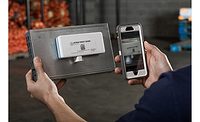Managing air circulation in snack and bakery production is critical to food safety








Snack and bakery production environments depend on air handling equipment for distributing heated and cooled air throughout buildings. In addition, the equipment can affect the workplace environment itself.
As is the case with every piece of equipment within a food production facility, proper maintenance and cleaning are critical, says Tim Kane, president/CEO, Goodway Technologies, Stamford, CT. “From the conveyor belts to packaging equipment, cleaning and sanitation is always top of mind. But proper cleaning goes beyond what you can just visually see.”
Neglecting air handling equipment cleaning and maintenance also impacts efficiency and safety. “When HVAC and refrigeration coils are not adequately cleaned, particles can build up and force the air handler to work harder, and the heat exchange process becomes less efficient,” says Kane. “This shortens the life of the equipment and causes it to consume more energy, which impacts operational costs.”
Neglect can also put employee safety and system efficiency at risk, Kane adds. “When HVAC and process cooling/heating systems are neglected, product quality can be impacted. Airborne contaminants, like bacteria and mold spores, can easily be transferred through HVAC systems, contaminating product at every cycle of the production process. Additionally, special care needs to be taken when dealing with airborne dust, like flour, sugar, cocoa, or other fine powders. If filters aren’t properly maintained, these deposits can accumulate in and on ductwork, causing possible explosive environments.”
New construction
A baking facility must maintain a positive air pressure relative to the outside ambient air pressure conditions in order to prevent the infiltration of airborne contaminants, such as mold, dust, insects, odors, and humidity, says David Watson, food, baking, and snack SME, The Austin Company, Cleveland.
“New facilities are generally designed in a linear fashion from raw ingredients through ingredient preparation, cooking, tempering/cooling, packaging, and shipping,” says Stuart Jernigan, director of preconstruction, A M King, Charlotte, NC. Airflow is designed in a reverse direction, meaning the most-positive section/zone of the plant is packaging, and the least-positive area is raw ingredient storage and preparation.
“All sections of the plant are positive relative to the outside ambient pressure to help prevent contaminants from the outside elements entering the plant. Cooking/baking areas present unique challenges, because many ovens have their own sources of supply and exhaust, and may require combustion air, so air balance in these areas becomes problematic and requires special attention. The best way to control proper air balance and quality is by using physical barriers or walls between zones,” Jernigan recommends.
This will also allow for differing levels of filtration, sanitation, and air changes, depending upon the product and at the stage in the production cycle, says Jernigan. “If the plant does not utilize conditioned air in the general areas, which is very often the case due to the tonnage that would be required, significant air changes are required in the 8 to 12 per hour range. Supply fans should be equipped with filters that have an efficiency rating of MERV 13 minimum or higher and be easily maintainable.”
The atmosphere in the room surrounding the ovens needs to be positive relative to the bake chamber, says Watson. “If the bake chamber becomes positive relative to the oven room area, a condition known as outgassing through openings in the bake chamber can occur. This provides the potential for moisture to condense on the oven insulation. It can also prevent products of combustion in the bake chamber, as well as VOCs formed during the baking process, to be properly exhausted.”
In the case of VOCs (ethanol), this can allow for the buildup of fugitive emissions in the building that bypass air emission control equipment designed to burn off the VOCs, Watson warns. “Some states—Ohio, for example—have enacted regulations that require controls to be in place to ensure a negative bake chamber condition is maintained at all times.”
All of these issues can be resolved through the appropriate airflow and building pressurization design, says Jerry Lyzen, PE, CEM, The Austin Company. “The first step to ensure proper pressurization of a facility is to divide the building into pressure zones. This requires differential pressure zones within the building that allow for air to flow from critical to less-critical areas.”
Watson says that in a bakery the ideal airflow would push the air from the mixing/makeup areas through to ingredient storage, while maintaining a positive pressure in ingredient storage relative to the outside air pressure. The oven room would maintain the highest air pressure relative to the makeup area on one side and cooling/packaging area on the other. “Airflow from cooling/packaging would then be designed such that air flows from this area into packaging storage, and ultimately into the shipping area.”
Equipment essentials
Goodway Technologies offers the CoilPro CC-200, a coil cleaner and vacuum system that can be used on indoor and outdoor HVAC and refrigeration coils, says Kane. “It’s a portable two-in-one coil cleaning solution that combines a powerful vacuum for easy cleanup and a unique cleaner/bio growth inhibitor all in one system. It uses a safe-on-coils pressurized water system to remove dirt, dust, and debris from a variety of coils.” The 8-gallon, built-in water tank offers portability, but facility personnel can also connect to a water source.
The CC-200 uses Goodway’s CoilShine-T tablets, which clean and protect the equipment simply through addition to the tank. Goodway also offers CoilShine-T-BIO to protect coils against odor and microbial growth.
Scott Houtz, president, Air Management Technologies, Lewisburg, PA, says that sometimes what is “old” can become “new” again, which is the case with its proprietary Environmental Conditioning systems for the baking process. “We have provided these systems for almost 20 years to about a dozen baking companies who provided us repeat business. The new FSMA standard has opened the door to many new bakeries who had previously viewed environmental systems as a product-cooling process instead of a critical food safety procedure.”
Environmental Conditioning consists of a multi-point approach to food safety and product quality through consistent temperature, space pressurization control, and proper filtration, to create a “clean room” environment, notes Houtz. “Our presentation this year at ASB BakingTECH focused on providing Environmental Control for food safety and quality and concentrating on how to manage areas where finished product was exposed compared to other process areas which required environmental control. The outlet of the oven to the product entering the packaging is commonly referred to as the finished product zone. In this zone it is important to establish a safe zone, the ‘clean room,’ which provides containment for the environmental conditioning process,” he explains.
While this may be challenging in some existing facilities, there are methods for even the most demanding applications. Once established, a “clean room” can offer benefits like:
- Consistent product temperature control regardless of the season
- Humidity management, which impacts product evaporation loss
- Air filtration to manage molds, insects, and other airborne particulates that can also carry microorganisms
- UV lighting that prevents the growth of molds and microorganisms on cooling coils and wet surfaces
- Enclosure pressurization that prevents infiltration of air from non-clean spaces
“This process is also important to control post-packaging issues that may occur from inadequate cooling and moisture management—molds, sugar bloom, etc.,” adds Houtz.
Healthway Products, Pulaski, NY, recently released a new version of its DFS filtration technology, notes Ryan Ritchie, EVP business development. The air purification system can filter out virus-sized particles and destroy them inside the filter system. “While the technology has been around for a few years, the form factor that allows these to work with existing HVAC systems is new. In addition, because we can filter out virus-size particles, we are being called on to provide systems in mission-critical locations fighting against COVID-19, and areas where we need to protect workers.”
CAMCORP, Lenexa, KS, has successfully developed a Post Blender Conditioner after a dry ingredient blending process where the customer wanted to keep the blended ingredients moving, says Tom Leach, Tom Leach, pneumatic conveying sales manager. “A circular flat bottom surge bin equipped with four horizontal sweep arms agitates a full blended batch, keeping the ingredients moving. The Post Blender Conditioner was placed at the outlet of the blender where the height was limited. Ingredients were agitated in the Post Blender Conditioner then discharged into a volumetric feeder for delivery to downstream processes. Different sizes are available based on the blender batch size. The Post Blender Conditioner includes side access doors to aid in cleaning and inspection. Sight glass were also included on the bin’s sidewalls. The bin is supported on T304 stainless steel leg supports and includes a gearbox and motor.”
Tight control
The airflow strategy for a snack food or baking process facility varies depending on allergens, products, and production methods and types, says Zach Becks, design manager, Gray, Lexington, KY. “Adjacencies of spaces, as well as people and product movement, must be identified to properly design an airflow strategy.”
Storage and preparation areas for ingredients like chocolates, mint, spices, sugar, and anything with allergens often require isolated rooms to achieve desired humidity, temperature, and special handling requirements, says Jernigan. This might require a distinct air unit equipped with filtration, and separate exhaust systems to prevent the transmission of aromas and particulates to other products.
Historically, most bakery ventilation systems provided minimal air filtration, but recent trends have customers requiring higher air filtration levels, says Jim Depew, VP of engineering, The Webber/Smith Group, Lititz, PA. “The recent trend is to provide a higher degree of air filtration driven by a desire to reduce food safety risks, even for products that have minimal moisture content where the risk of mold and bacterial growth is low.”
When multiple rooms have different environmental requirements, separate air handling units are needed to provide the specific air characteristics for each room, says Depew. “Although there may be a need to incorporate multiple air handling systems, these systems need to work in unison to maintain desired airflow patterns and proper space pressurization.”
In the past, most baking operations were not air conditioned, but a general rule-of-thumb was to provide 20 to 25 air changes per hour, Depew notes. “Most of the airflow was attributed to providing heat relief in oven areas. Humidity control is also important for those areas where washdown sanitation practices are used.”
Many food manufacturing processes require specific temperature and humidity conditions for optimal quality and consistency, says Lyzen. “For example, in areas of the building where chocolate is being applied to products by either an enrobing or bottoming process, the ideal conditions are 65 to 70˚F, with relative humidity not to exceed 50 percent. In addition, products requiring a sugar-based icing application should be maintained at 70 to 72˚F, while maintaining a relative humidity of 50 percent.”
Other areas of the building requiring temperature and humidity control are the areas where finished products are exposed to the open air prior to entering final packaging, Watson notes. “For example, if cookies are exposed to high humidity conditions for too long of a period prior to being inserted into the final package, shelf life of the product can be greatly impacted. This is why maintaining 65 to 70˚F in the packaging areas, and 50 percent relative humidity or less, is critical.”
Looking for a reprint of this article?
From high-res PDFs to custom plaques, order your copy today!











